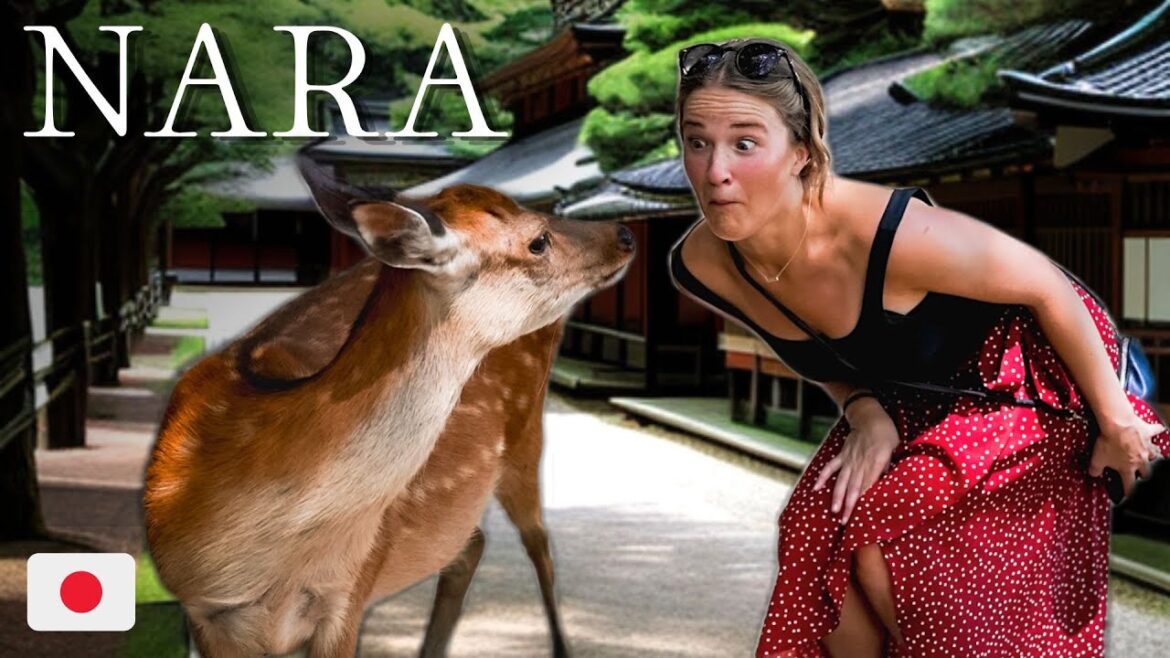Nara, Japan is unquestionably a booming tourist destination. With Nara constantly surging in searches on various social media platforms, we felt like we had to come to Japan’s first capital to see what the hype was about. Nara is just a short train ride from Osaka & well worth the day trip. Come along with us today as we explore the best of Nara, from feeding the deer, to exploring Nara Park. Oh, & did we mention Nara is the birthplace of modern sake? THIS is why Nara is going viral right now, & why you shouldn’t miss it if you’re making a trip to Japan.
► Subscribe – https://bit.ly/ProbablyLostSubscribe
► Find Us On Social Media – https://linktr.ee/probablylost
Buy Us A Coffee if you’d like!:)
► https://www.buymeacoffee.com/ProbablyLost
Wonder where we get our royalty-free music? Click HERE:
https://www.epidemicsound.com/referral/dzp8yu


38 Comments
よもぎもちのよもぎは毒消しです。きなこと小豆も毒消しです。滋養にとてもいいのです。日本の食べ物は医食同源です。
Even from the Japanese point of view, the deer in Nara is strange. Please love him😊
一番鹿の模様の綺麗な季節ですね!美しい映像ありがとうございます。
鹿せんべいは先に丸ごとバッグなどに隠してから一枚ずつそっと取り出してあげると良いですよ!
画質が綺麗ですね!
鹿が神の使い(使徒)って一神教徒のキリスト教では分かり難い方も多い気がします。トイレから竈に下駄まで高低の差はあれ神が宿る多神教国家が独自に進化した風土性ですからね。
こんにちわ!😁
Before Nara became the capital, the capital changed one after another with the accession of new emperors. However, most of them were in and around Nara. What is clear is that it has already been 2100 years since the accession of the first emperor.
超実写版クールポコ!😊
大流行だったんですか!?日本人なのに知らなかったWW
13:39 Cute and Funny😄
If there are so many deer in places other than Japan, the ground will be full of feces and they may be exterminated. Daily cleaning is required to keep this place clean and odor free. But I don't know why wild deer are clean. I don't think they are washed like zoo animals and pets. Anyway, both deer and humans need love for this situation to work.
Too many tourists in Japan 😅😅😅😅
Over tourism is a real issue now to the point they put a limit on mt fuji while I was there 😅
Greetings from korea 🇰🇷 😊❤
Japan is a quiet country. Please don't be noisy.
夏の奈良と京都は死ぬほど暑いので気をつけて
奈良の鹿たちは全く飢えていません。彼らの住処の山には殆ど無限に食べ物があります。生活に困っていません。恋愛は自由です。
彼らは、人間の旅行客たちと同じように、奈良公園に遊びに来ているのです。
彼らは売り場のせんべいには見向きもしません。すぐ目の前にあっても、それを食べようとはしません。必要ないからです。そして、そんなことをしても嫌われるだけで、全然楽しくないことを知っているのです。
彼らは、鹿せんべいを買った人から、せんべいをもらいます。喜ばれることを知っているのです。喜んだり騒いだりする人間たちを見て、彼等も喜び楽しんでいるのです。つまり人間たちと遊んでいるのです。
There isn’t trash box in street.
So you can dispose it convenient store.
If not please have a plastic bag in your backpack.
I wouldn't want to step on poop. Many animals means there must be many poop. Deer's poop are tiny, difficult to detect. I don't want my shoes to smell.
餡子の餅は緑茶と一緒に食べるととてもおいしいですよ
Mr.ビーン知ってる?😊
Feeding deer in Nara park are not at all dangerous. What are you talking about ???
I think you are projecting your fear of (so called) wild animals. Their antlers are culled
every year and I heard no injuries caused by deer attack ever reported.
But more on Nara itself. As it is the oldest capital of Japan 710-794 AD.
The custom of those days were such each successive emperor must choose a new
location to omit curse left by pervious ruler, sometimes even during the time he is still
in the throne whenever they consider any evil spirits are affecting current royal family.
Therefore there are so many real ancient ,historical and beautiful temples and shrines
scattered around in concentrated area along with ruins of former palaces.
My at most recommendation is HOURYUUJI Temple the oldest wooden structure in
the world with famous 5 tier pagoda as well as national treasure 3 Buddhist sculptures.
As well as BYOUDOU IN shrine in Uji which is situated between Nara and Kyoto.
Still it would be difficult to see them all in one day so I suggest you stay at least 2 nights
and maybe even rent a car unless you want to ride local transportations. In that case
make sure you check schedule for the bus/train etc. since some of them run less often
compare to the cities.
I live near "Harusika Sake".
Deer sometimes come my house.
Come agein!!
日本は世界一長い歴史を持っている国
日本は経済大国
日本は観光地が多い
素晴らしい
645年に難波宮が日本最古の首都ですね。現在の大阪市です。
日本人もあまりこの事実を知りません。
Just discovered you guys and subscribed, love the vibe of the video! ❤ Great way to show the sake experience using photos 🤣
The history of Japan is very old, about 2,000 years since the Emperor's reign, but humans began to live in villages and communities in this island nation about 14,000 years ago, during “the Jomon pottery” culture.
The country name word "NIPPON”(Japan) means "the land under the sun" , but another name is "WA" or "YAMATO" , meaning “Peacefully Harmony among People and with Nature”. So, Japan's name means “the Land under the Sun” and” the Land of "Great Harmony of People and Nature,”
In this island nation surrounded by the sea on all sides, since ancient times, people have lived peacefully in groups, respecting harmony, and living in harmony with nature and enjoying the blessings of nature. The original country names from ancient times "YAMATO, WA" reflect their wishes and realities.
In public places where everyone gathers, everyone should act in a way that “Do not disturb others.“
If all participants can act in a way that “you do not cause trouble to others," that is, at the same time, it will create an environment in which “No one cause trouble to you”
The same is true if we substitute the phrase "everyone always help others in need.” If everyone does this, it will create a social situation in which "when you are in trouble, someone will help you.”
This is a very rational group wisdom to live in peace with each other.
This is not for the sake of any particular person, but in order to live equally comfortably with each other, the obligation to act for the peace of mind of "all participants with each other" also arises.
Therefore, they believe that the right thing to do in public places is not to bother others, even if there are no garbage cans, to take home garbage that they have soiled themselves and dispose of it on “their own responsibility”, and not to throw garbage away in public places where it will bother others.
This is because they have been taught through their childhood “education” that this is an ancient teaching, a tradition, and “a natural duty of adults.”
It is a teaching and a rule of life that has been handed down in this island nation since ancient times.
“A peaceful environment can only be built through mutual give and take, each other.”
One for all, all for one, the sprits of OTAGAI-SAMA, TASUKEAI (help each other, everyone)".
”In times of trouble, we are there ,help for each other.”(Komatta Toki ha Otagaisama)
Because of its so long history, the Japanese themselves are unaware that they themselves have an "unknown no-named religion”. However, they have inherited it through the long history of this island nation.
They have lived collectively in their island environment for more than 14,000 years, and this has given them the wisdom of life to survive in that environment, which is condensed in the traditional Japanese teachings.
Two factors (an island nation's natural environment and geopolitical isolation) are the reasons why Japan is different from other Asian nations and historically gave birth to a unique Japanese culture.
This is a humid island nation blessed with abundant nature and plentiful water and food, so people began to form communities and settle down on this land from time immemorial.
However, where there is light, there is always a shadow.
What makes this island nation livable is that it is a paradise for breeding not only for humans but also for bacteria that are toxic to humans. Surrounded by the sea, the volcanic island was at the same time harsh due to its location.
The people who lived on the island in the old days made the most of the positive aspects of the island and maximized the benefits of nature, while at the same time devising countermeasures to eliminate the harsh negative aspects by focusing on wisdom from various aspects.
In the past, when science, technology, and medicine had not yet developed, the reality must have been that a single person's selfishness or lazy attitude toward life could lead to an outbreak of infectious diseases or fire that could endanger the lives of the entire village or community and cause extinction.
In order to eliminate this, it was important for all residents to work together to maintain and improve public places in a livable manner, and this gave birth to the idea that everyone must work together to achieve this goal.
And in order to realize this, it is necessary to thoroughly educate people about public behavior from an early age. These characteristics of the Japanese people, such as their love of cleanliness and their unwillingness to cut corners on organization, were an adaptive behavior to the harsh aspects of this island nation.
Why do Japanese people seem on the surface to welcome the behavior of foreigners who come to Japan for sightseeing, but at heart they look at them coldly?
This is actually not because of racism, but because of their unconcerned behavior in violating Japanese-style rules.
This is because many continental-born foreigners, who are not familiar with the rules of life in this island nation, do not understand the meaning of Japan's unique rules of behavior and unconsciously ignore the rules in their own country's way of behavior.
This is because foreign tourists do not realize that this is a "very dangerous behavior" that can cause disasters from the perspective of this island nation, which is also a harsh environment. It is easy to understand why this country adopted isolationism during the 265 years of the Edo period (1603-1868), when considered from the perspective of environmental differences with the Eurasian continent.
So once you enter this island, it doesn't matter if you are foreigner or Japanese, “all people are equally” expected to cooperate and contribute their behavior to make life comfortable for each other. " We act with each other so as not to cause trouble for others."
Because if even “one person stops this”, the comfortable environment “will disappear” in an instant.
Surprisingly, a unique and advanced civic cultural consciousness has existed in Japan since ancient times, don't you think?
映像のクオリティ、撮影・編集テクニックが他のYoutubeチャンネルと違い、雰囲気まで伝えるような感じがあってすばらしいですね。
There are Zombie Deer in Nara, but you didn't cover that. Interesting 🤔.
鹿が闊歩する街ってのは確かに不思議空間です 時間を忘れて和めます
色んな国から外国人旅行者が来るが、鹿を蹴ったりなグッタリ巣ののは中国人だけだ
(^○^)きゃははははははははははは~♬ぷっ
In 710, Nara was a wonderfully planned city with a grid of streets. But 80 years later, it was abandoned and no trace of it can be seen today.
GOOD!JAPAN!
Thank you for introducing Nara which is my homeland. I really enjoyed your video. By the way, although the fact that the original Nandaimon gate of Todaiji temple was destroyed by typhoon in 8th century as you mentioned, the gate stand still now was rebuilt in 1203. So, is it adequate to call it 'replica' ? It's old enough, one of the oldest wooden building, isn't it? Audiences would miss understand it. Of cause, the oldest building made of wood around world is Hohryuji temple's five-storied pagoda made in 607A.D. also in Nara, you know. It's definitely must see site.
Do not touch!!!!!!!!!!!!!
Your scent sticks to the deer
どうせ行く奈良ここでしょう(^^♪
お鹿さまで奈良の観光客が増える事は良い事だとは思うのですが、
ここの鹿は野生の鹿であって飼われている鹿では無いのです。
その内、観光客が鹿によって怪我をしても誰も責任は取らないと云う事を
官公庁は公式に示さないと後にまずい事になるのではないかな?!
あれだけで餅がつきあがるのは不思議だ
Hey guys, you must be astonished if you hear the following fact:
Aftermath the W W II, the pagoda of Kofukuji temple was put on sale!
The national treasure of over 1300 years history.
And the auction price was 1500 yen!
Quite fortunately, those days Japanese were so poor, and no one responded.
鹿には触れないでください。
神の使いですから、間違った行動を動画にしないでください。あなた達は慎重であるべきです。